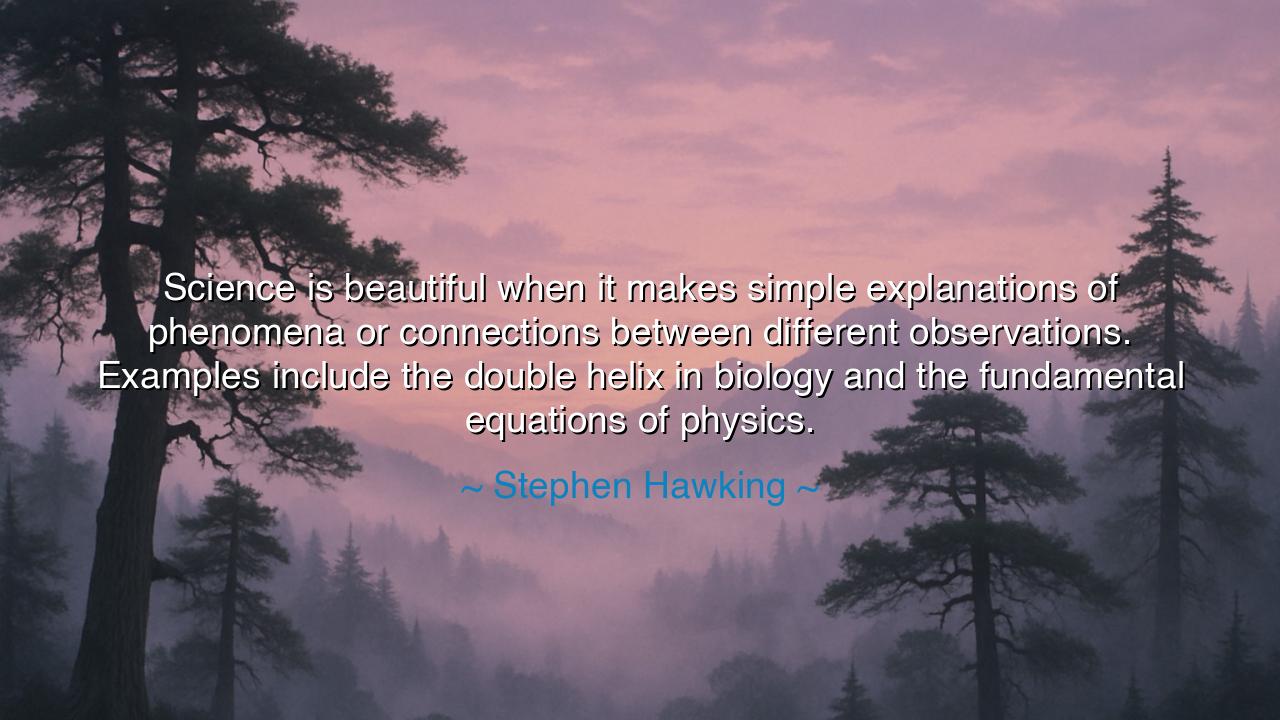
Science is beautiful when it makes simple explanations of
Science is beautiful when it makes simple explanations of phenomena or connections between different observations. Examples include the double helix in biology and the fundamental equations of physics.






"Science is beautiful when it makes simple explanations of phenomena or connections between different observations. Examples include the double helix in biology and the fundamental equations of physics." These words, spoken by the great Stephen Hawking, carry with them the profound truth that science, at its finest, is not simply about complexity or technical mastery. No, science at its heart is about clarity, about the awe-inspiring simplicity that arises when the mysteries of nature reveal themselves in a form that can be understood by the human mind. It is in these moments, when the great truths of the universe are distilled into elegant, simple ideas, that science becomes not only a pursuit of knowledge, but an act of profound beauty.
The ancients, too, revered the idea of simplicity in understanding the world. In the halls of Plato’s Academy, wisdom was not thought to be hidden in complexity, but in the underlying principles that could explain the vastness of the cosmos. The Pythagoreans sought the simplicity of numbers to explain the harmony of the universe, while Aristotle pursued the underlying causes of nature’s phenomena. They understood that the pursuit of truth was not a mere exercise in accumulating facts, but a journey to uncover the simple, universal laws that govern the world. In this way, Hawking’s words resonate with the spirit of the ancients, who, through their inquiries, sought to find the elegant unity that bound all things together.
Consider the moment when James Watson and Francis Crick uncovered the structure of the double helix in biology. It was a discovery that shook the very foundation of life itself. In the swirling strands of DNA, they found not a chaotic, disordered tangle, but a beautifully organized structure—one that could explain how life replicated itself and evolved. This simple elegance, this connection between different observations about genetics and biology, illuminated the complexity of life in a way that had never before been imagined. Hawking would have called this "beautiful science," for in the simplicity of the double helix, humanity could finally see the blueprint of life itself.
And yet, the elegance of science is not confined only to biology. The fundamental equations of physics, such as Einstein’s theory of relativity and Newton's laws of motion, represent another example of beauty in simplicity. To many, these equations may seem intimidating at first, but they contain within them the grand truths of the cosmos, distilled into forms that the mind can grasp. Through these simple equations, the heavens and the earth are brought into harmony, revealing the unseen forces that govern motion, gravity, and time. The very simplicity of these equations—how they tie together disparate observations into a cohesive understanding—invites awe and reverence. They show us that the universe is not a chaotic, unknowable place, but a system that can be understood, that can be explained, and that, in understanding, we find beauty.
Hawking’s words, then, remind us that science is not merely a collection of facts or a progression of complex theories. It is an unfolding journey toward understanding, one where the mysteries of the universe are revealed in the simplest of forms. It is in these moments, when complexity is distilled into simplicity, that we truly begin to see the beauty of the world around us. This is the lesson for all who seek knowledge: that the highest form of understanding is not found in complexity, but in the clarity that arises when different observations come together in a simple, unified truth.
The lesson for us, as we walk through the world of discovery, is this: seek simplicity, seek clarity, and seek connection. When we look at the world—whether through the lens of science, philosophy, or art—let us remember that the most profound insights are often the simplest. In our own lives, let us not become bogged down by complexity for the sake of complexity. Instead, seek the connections that tie all things together, and in that pursuit, you will find that the simplest answers often lead to the most profound understanding. Whether in the stars above or in the life around us, the beauty of science lies in its ability to reveal the profound truths of the universe in forms we can comprehend.
In your own journey, take a moment to reflect on the simplicity that surrounds you. Just as Hawking found beauty in the elegance of the universe, so too should you find the beauty in your own path. Let the mysteries of life, whether in the realm of knowledge or in the quiet moments of reflection, be approached with the spirit of simplicity and wonder. For it is in this simplicity that you will uncover the deepest truths and the most enduring beauty—both in science and in life itself.






AAdministratorAdministrator
Welcome, honored guests. Please leave a comment, we will respond soon